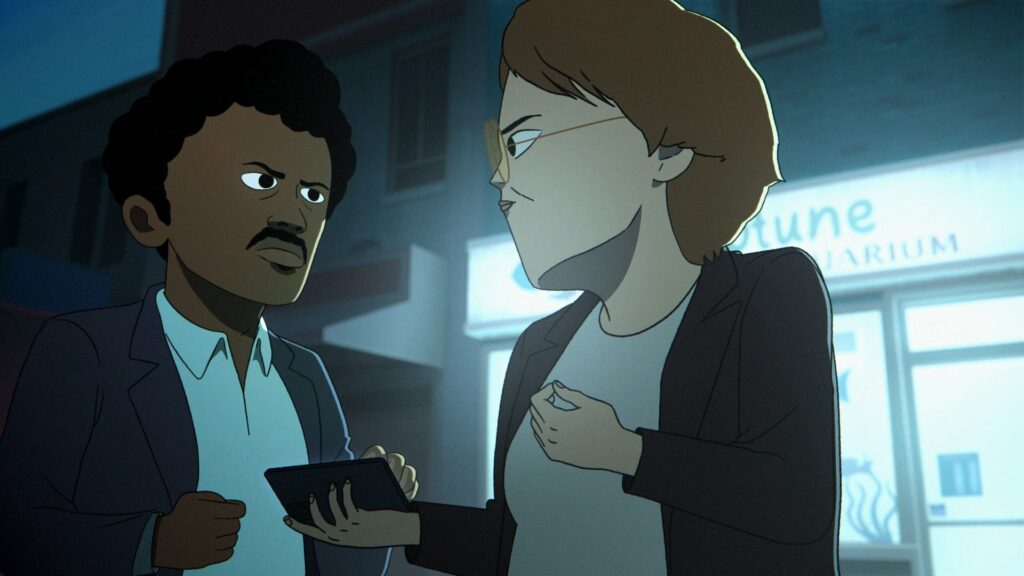Back when viewers first met DEA Agents Copano and Harrington in Adult Swim’s Common Side Effects, these two were anything but serious. Straight-laced, tough-talking agents? Yeah, right. Copano and Harrington came in shimmying hilariously to Harry Belafonte’s cheerful “Jump in the Line,” instantly earning fans’ affection. At first glance, their primary job seemed delivering goofy moments and playful banter. But as the series unfolded, these fan-favorites began to reveal surprising layers and unexpected depth – and by the finale, audiences knew that initial goofiness masked far richer emotional complexity.
First Impressions: Quirky Duo Dancing to Their Own Beat
When creators Joe Bennett and Steve Hely unveiled the characters, the intention was never just comedic relief. Yet, that’s exactly how they first appeared. Copano, voiced by Joseph Lee Anderson, burst onto the scene with his boundless enthusiasm for conspiracy theories, a refreshing twist on the typical “straight-laced Fed” stereotype. Whether passionately rambling about government cover-ups or alien invasions, Copano’s conspiracy-fueled excitement regularly landed both characters in amusing trouble. You couldn’t help but chuckle at how seriously he took even the craziest theory.

Opposite him stood Martha Kelly’s Harrington: cautious, practical, yet surprisingly clumsy in her personal life. Harrington often found herself caught off guard by everyday human interactions, such as awkwardly navigating the unpredictable world of dating apps. Watching her nervously fiddle with profiles or stumble gracelessly into dates provided genuine comedy gold that felt relatable. Their odd-couple chemistry immediately stood out as uniquely entertaining – even amid an already eccentric cast of characters.
So, initially, viewers saw Copano and Harrington as a typical, amusing partnership. There was the conspiracy buff enthusiastically diving down rabbit holes, and his partner constantly tidying up his messes. They were fun, charming comic relief but hardly heroes. Not yet.
From Silly Situations to Serious Stakes
Gradually, though, the writers began allowing these two lovable goofballs to evolve. As Bennett and Hely shared in interviews, their approach deliberately avoided simplistic good guys and villains. Instead of clear-cut roles, they favored complex, ever-changing figures navigating moral ambiguity. Therefore, it made sense that Copano and Harrington couldn’t stay merely funny forever.

Over several cleverly crafted episodes, we glimpsed these deeper currents beneath the comedic surface. Harrington, at first timid and overly cautious, gradually became braver. Personal relationships taught her compassion, responsibility, and engagement beyond her direct duties – something unimaginable at first.
For example:
- She awkwardly balanced workplace stress with genuinely heartfelt attempts at romance, revealing vulnerability she initially hid behind dry one-liners.
- Her persistent awkwardness suddenly gave way to unexpected acts of courage, catching viewers – and even Copano – completely by surprise.
Copano, meanwhile, turned his fanatic conspiracy-driven enthusiasm into real investigative skill. True, he couldn’t resist the occasional wild tangent about secret societies or shadowy agencies. But his openness showed genuine inquisitiveness that was key to uncovering the truth. His initially over-the-top reactions gradually felt less absurd as he got closer to real danger. He began backing up those theories with genuine evidence, transitioning from a lovable oddball into a trustworthy ally.

Beneath the laughs and amusement, their shifting dynamic became crystal clear. These two were changing, in part due to the investigation itself. The creators explicitly acknowledged this transformation, explaining that investigating Marshall and Frances’ unusual experiences challenged Copano and Harrington’s initial beliefs. Their formerly rigid official stances started softening, pushed by newfound experiences and friendships forged on their complex case.
Funny Versus Poignant: Striking a Perfect Balance
One of the real highlights was how the writers managed humor alongside deeper, emotional moments. Often, Copano and Harrington would deliver funny sequences that resonated surprisingly deeply afterward. For instance, when Copano once proudly produced a giant pin-board covered with conspiracy red strings, audiences first laughed. But later, viewers saw genuine heartbreak as his theories turned unsettlingly true. That shift – from hilarity to real emotional tension – marked a clever storytelling move.

Similarly, Harrington’s clumsy dating scenes started hilariously awkward. From mismatched online chats to cringeworthy restaurant confrontations, her dating misadventures were comedic gems. However, these comedic mishaps gradually revealed loneliness beneath her stoic demeanor. These events humanized Harrington in powerful ways audiences never expected, turning a good joke into meaningful commentary.
Some standout moments beautifully balanced comedy and intimacy, such as:
- Copano confidently launching into one of his dramatically absurd theories in an attempt to convince skeptical coworkers, generating genuine laughs.
- Harrington quietly comforting Marshall or Frances in moments of emotional turmoil, displaying unexpected empathy and care beneath her usually icy front.

Fans embraced this intricate blend because it felt genuine – funny enough to amuse, sincere enough to resonate emotionally. That careful equilibrium ensured viewers grew affectionate toward these two agents over the episodes. Once only laughing at their quirks, audiences gradually began cheering them on wholeheartedly as deeper issues arose.
By the Finale: Unlikely Heroes Emerge
By the time the finale approached, these quirky DEA agents had evolved dramatically. The season’s climax truly showcased that growth.
Viewers watched Harrington make an incredibly selfless decision, utilizing a powerful, symbolic mushroom to literally heal her wounded partner Copano. Earlier episodes might’ve presented such a scene as purely comedic; now, it carried genuine emotional meaning. Healing Copano symbolized their transformative journey from humorous foils to compassionate heroes.

Her heroic act didn’t end there; Harrington vowed explicitly to assist protagonists Marshall and Frances, dramatically highlighting how much she had changed since first being introduced. Seeing her openly express newfound allegiance beyond bureaucratic procedure delivered meaningful narrative impact.
Copano, on the other hand, saw his once humorous conspiracy obsessions validated in startling ways. His quirky beliefs first seemed absurd – now they had underpinning truths, greatly vindicating him. This transformation from a funny hobbyist to a capable, insightful investigator felt authentic and intensely rewarding to viewers.

In a show packed with constant surprise twists, watching Copano slowly realize his eccentric theories held real merit turned deeply satisfying. By the finale, you genuinely cared about his successes – and completely forgot he once appeared solely as comedic relief.
Goofballs Grow Up, but Stay Lovable
Ultimately, the brilliance of Copano and Harrington in Common Side Effects lay within the meaningful transformation the writers crafted, aligning perfectly with the show’s overarching theme of moral complexities and change. Viewers initially fell for the quirky antics, the relatable fumbling, and awkward banter. But as the story evolved, both characters gracefully stepped far beyond comic relief, directly into the heart of deeper storylines audiences hadn’t predicted they’d reach.

In interviews, creators Bennett and Hely emphasized this type of intentional complexity. These beloved characters’ beliefs genuinely shifted throughout investigation, reflecting the real-world ambiguity and moral trade-offs law enforcement regularly faces. They showed that belief isn’t static – it changes given circumstances, experiences, and emotional growth, a fact vividly portrayed through these agents’ compelling arcs.
When Copano and Harrington wrapped their journeys, audience perceptions completely reversed. Fans originally laughed at the dancing DEA agents bumbling into wild conspiracies. Now they applauded, invested emotionally, genuinely rooting for them in ways none anticipated during that first silly introductory dance.

So, these two transformed vividly throughout Common Side Effects: from simple laughs to complicated affection. Viewers initially smiled watching Copano’s goofy enthusiasm and Harrington’s charming dating misadventures – but by the finale, they’d fallen in love with something richer and deeper.

After all, who doesn’t cherish the goofballs who surprise us most?




